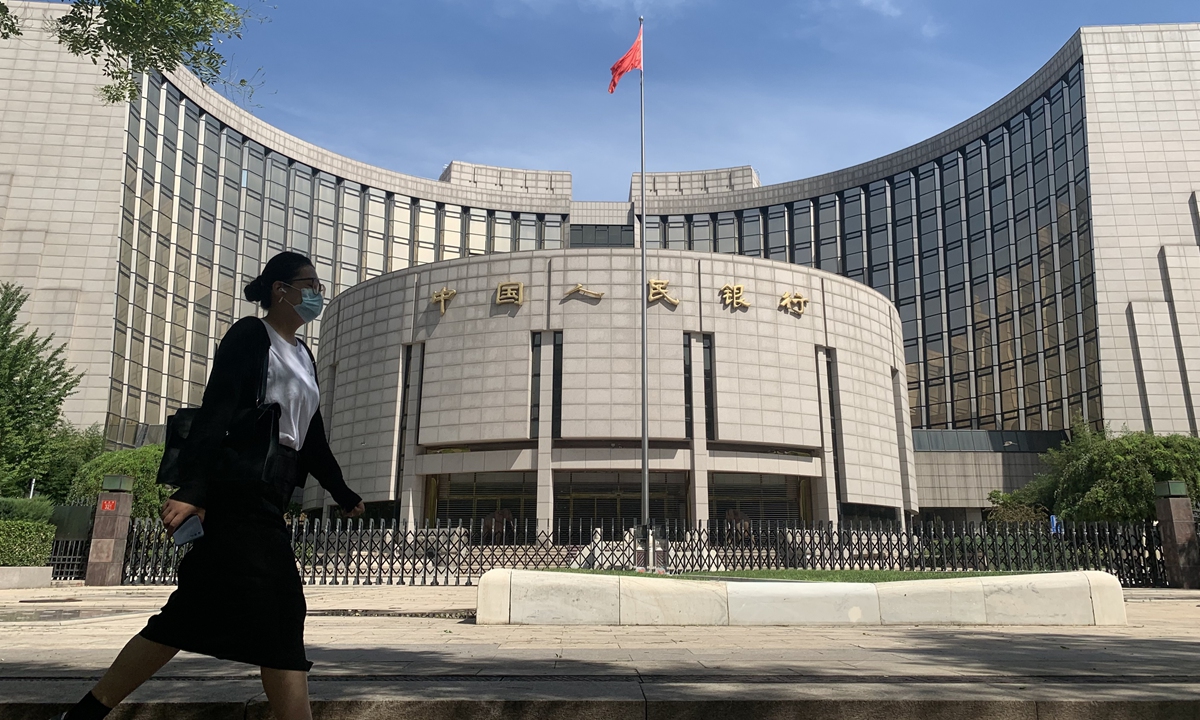
A view of the PBC building in Beijing Photo: VCG
China's monetary policymakers have a rich toolbox and ample options, and there is still further room to slash the reserve requirement ratio (RRR), Pan Gongsheng, governor of the People's Bank of China (PBC), the central bank, said on Wednesday.
Speaking at a press conference during the ongoing second session of the 14th National People's Congress, Pan said that the average RRR of China's banking industry, which is the proportion of money that lenders must hold as reserves, remains at 7 percent currently and there's room to cut it further.
Pan said that the PBC will pay more attention to striking a balance between the short term and the long term, between seeking steady growth and preventing risks, and between internal equilibrium and external equilibrium in its monetary policy regulation.
The PBC will also strengthen counter-cyclical and cross-cyclical adjustments while focusing on boosting market confidence and stabilizing expectations and prices to create a favorable monetary and financial environment for the economy's operations and development.
The considerations outlined by Pan underscore the resilience of China's monetary policy with further room to respond to unexpected situations, Sun Lijian, director of the Financial Research Center at Fudan University in Shanghai, told the Global Times on Wednesday.
China's high-quality deployment targeting investment has created various channels for implementing the country's monetary policy and broad scope for fiscal policy to take effect, Sun said. He added that the utilization of monetary policy for supporting fiscal policy and the real economy through the financial sector will be a major focal point for boosting domestic demand.
Sun noted that implementing a flexible and appropriate monetary policy to ensure adequate liquidity will help tackle external challenges amid the current complex global environment, which may lead to unstable investment flows, stressing the significance of adapting structural monetary policy instruments for uncertainties.
Pan said that the Chinese central bank will utilize comprehensive monetary policy tools to achieve targets, such as maintaining a reasonable level of liquidity.
In 2023, the PBC lowered the RRR twice by 0.25 percentage points each time. It cut the RRR by 0.5 percentage points in February this year, which provided 1 trillion yuan ($138.9 billion) of long-term liquidity to the market, Pan said.
In addition to maintaining reasonable growth, Pan said that the PBC will continuously lower the cost of social financing in a steady manner. The central bank will approach maintaining price stability and promoting a moderate price rebound as significant considerations for its future monetary policy, while considering the soundness of banks' balance sheets, Pan noted.
Pan said that the central bank cut interest rates twice in 2023 and guided major banks to lower deposit rates while making a cut of 0.25 percentage points for the five-year loan prime rate (LPR) in February, as these measures will firmly contribute to lower financing costs and supporting investment and consumption.
The RRR and LPR cuts indicate a significant increase in monetary policy support for the economy, which helps accelerate the recovery and boost market confidence in the improvement of economic growth and corporate profits, Chang Haizhong, executive director of corporates at Fitch Bohua, said in statement sent to the Global Times on Wednesday.
Chang expects that the LPR will be lowered twice more this year by a total of 20 basis points, and the RRR for financial institutions will continue to decrease, too.
China should implement a prudent monetary policy in a flexible, appropriate, targeted and effective way, and should improve the monetary policy transmission mechanism to prevent funds from sitting idle or simply circulating within the financial sector, according to China's 2024
Government Work Report, which was delivered on Tuesday.
The central bank will further increase the efficiency of monetary policy in promoting economic restructuring and maintaining the exchange rate at a reasonable and stable equilibrium level, Pan said.
Pan said the main participants in the foreign exchange market have become more mature with a growing number of business entities using exchange rate hedging tools and the yuan for cross-border settlement, as the fundamentals of China's economy continue to rebound and improve.
As of February, the yuan's share in cross-border payments for merchandise trade in China reached 30 percent, according to Pan.




